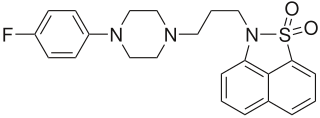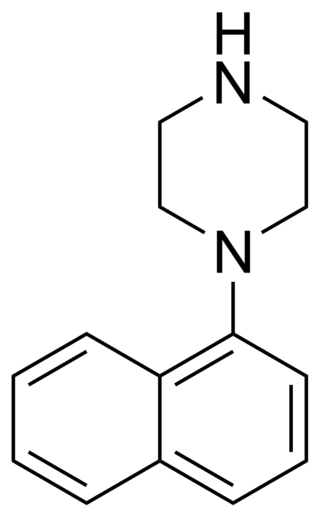
Ritanserin, also known by its developmental code name R-55667, is a serotonin antagonist medication described as an anxiolytic, antidepressant, antiparkinsonian agent, and antihypertensive agent. It was never marketed for medical use due to safety problems but has been used in scientific research to study the serotonin system.

The 5-HT2A receptor is a subtype of the 5-HT2 receptor that belongs to the serotonin receptor family and is a G protein-coupled receptor (GPCR). The 5-HT2A receptor is a cell surface receptor, but has several intracellular locations. 5-HT is short for 5-hydroxy-tryptamine or serotonin. This is the main excitatory receptor subtype among the GPCRs for serotonin, although 5-HT2A may also have an inhibitory effect on certain areas such as the visual cortex and the orbitofrontal cortex. This receptor was first noted for its importance as a target of serotonergic psychedelic drugs such as LSD and psilocybin mushrooms. Later it came back to prominence because it was also found to be mediating, at least partly, the action of many antipsychotic drugs, especially the atypical ones.

BIMU-8 is a drug which acts as a 5-HT4 receptor selective agonist. BIMU-8 was one of the first compounds of this class. The main action of BIMU-8 is to increase the rate of respiration by activating an area of the brain stem known as the pre-Botzinger complex.

The 5-HT3 antagonists, informally known as "setrons", are a class of drugs that act as receptor antagonists at the 5-HT3 receptor, a subtype of serotonin receptor found in terminals of the vagus nerve and in certain areas of the brain. With the notable exceptions of alosetron and cilansetron, which are used in the treatment of irritable bowel syndrome, all 5-HT3 antagonists are antiemetics, used in the prevention and treatment of nausea and vomiting. They are particularly effective in controlling the nausea and vomiting produced by cancer chemotherapy and are considered the gold standard for this purpose.
A serotonin antagonist, or serotonin receptor antagonist, is a drug used to inhibit the action at serotonin (5-HT) receptors.

The 5-HT7 receptor is a member of the GPCR superfamily of cell surface receptors and is activated by the neurotransmitter serotonin (5-hydroxytryptamine, 5-HT) The 5-HT7 receptor is coupled to Gs (stimulates the production of the intracellular signaling molecule cAMP) and is expressed in a variety of human tissues, particularly in the brain, the gastrointestinal tract, and in various blood vessels. This receptor has been a drug development target for the treatment of several clinical disorders. The 5-HT7 receptor is encoded by the HTR7 gene, which in humans is transcribed into 3 different splice variants.

Sarpogrelate is a drug which acts as an antagonist at the 5HT2A and 5-HT2B receptors. It blocks serotonin-induced platelet aggregation, and has applications in the treatment of many diseases including diabetes mellitus, Buerger's disease, Raynaud's disease, coronary artery disease, angina pectoris, and atherosclerosis.

Fananserin (RP-62203) is a drug which acts as a potent antagonist at both the 5HT2A receptor, and the Dopamine D4 receptor, but without blocking other dopamine receptors such as D2. It has sedative and antipsychotic effects, and has been researched for the treatment of schizophrenia, although efficacy was less than expected and results were disappointing.

Spiroxatrine is a drug which acts as a selective antagonist at both the 5-HT1A receptor and the α2C adrenergic receptor. It is an analog of spiperone and also has some dopamine antagonist effects.

RS-102221 is a drug developed by Hoffmann–La Roche, which was one of the first compounds discovered that acts as a potent and selective antagonist at the serotonin 5-HT2C receptor, with around 100x selectivity over the closely related 5-HT2A and 5-HT2B receptors. It has anxiolytic effects in animal studies, increases the effectiveness of SSRI antidepressants, and shows a complex interaction with cocaine, increasing some effects but decreasing others, reflecting a role for the 5-HT2C receptor in regulation of the dopamine signalling system in the brain.

AMDA (9-Aminomethyl-9,10-dihydroanthracene) is an organic compound which acts as a potent and selective antagonist for the 5-HT2A receptor. It has been used to help study the shape of the 5-HT2A protein, and develop a large family of related derivatives with even higher potency and selectivity.

Isamoltane (CGP-361A) is a drug used in scientific research. It acts as an antagonist at the β-adrenergic, 5-HT1A, and 5-HT1B receptors. It has about five times the potency for the 5-HT1B receptor over the 5-HT1A receptor. It has anxiolytic effects in rodents.

SDZ SER-082 is a drug which acts as a mixed antagonist for the 5-HT2B and 5-HT2C serotonin receptors, with good selectivity over other serotonin receptor subtypes and slight preference for 5-HT2C over 5-HT2B. It has been used in animal studies into the behavioural effects of the different 5-HT2 subtypes, and how they influence the effects of other drugs such as cocaine.

Spiramide (developmental code name AMI-193) is an experimental antipsychotic that acts as a selective 5-HT2A, 5-HT1A, and D2 receptor antagonist. It has negligible affinity for the 5-HT2C receptor.

Serotonin antagonist and reuptake inhibitors (SARIs) are a class of drugs used mainly as antidepressants, but also as anxiolytics and hypnotics. They act by antagonizing serotonin receptors such as 5-HT2A and inhibiting the reuptake of serotonin, norepinephrine, and/or dopamine. Additionally, most also antagonize α1-adrenergic receptors. The majority of the currently marketed SARIs belong to the phenylpiperazine class of compounds.

1-(1-Naphthyl)piperazine (1-NP) is a drug which is a phenylpiperazine derivative. It acts as a non-selective, mixed serotonergic agent, exerting partial agonism at the 5-HT1A, 5-HT1B, 5-HT1D, 5-HT1E, and 5-HT1F receptors, while antagonizing the 5-HT2A, 5-HT2B, and 5-HT2C receptors. It has also been shown to possess high affinity for the 5-HT3, 5-HT5A, 5-HT6, and 5-HT7 receptors, and may bind to 5-HT4 and the SERT as well. In animals it produces effects including hyperphagia, hyperactivity, and anxiolysis, of which are all likely mediated predominantly or fully by blockade of the 5-HT2C receptor.

PRX-08066 is a drug discovered and developed by Predix Pharmaceuticals [Dale S. Dhanoa et al. Patent US 7,030,240 B2], which acts as a potent and selective antagonist at the serotonin 5-HT2B receptor, with a 5-HT2Bbinding affinity (Ki) of 3.4nM, and high selectivity over the closely related 5-HT2A and 5-HT2C receptors and other receptor targets. PRX-08066 and other selective 5-HT2B antagonists are being researched for the treatment of pulmonary arterial hypertension, following the discovery that the potent 5-HT2B agonist norfenfluramine produces pulmonary arterial hypertension and subsequent heart valve damage. In animal studies, PRX-08066 has been found to reduce several key indicators of pulmonary arterial hypertension and improved cardiac output, with similar efficacy to established drugs for this condition such as bosentan, sildenafil, beraprost and iloprost. It is also being researched for potential anti-cancer applications, due to its ability to inhibit fibroblast activation.

F-15,063 is an orally active potential antipsychotic, and an antagonist at the D2/D3 receptors, partial agonist at the D4 receptor, and agonist at the 5-HT1A receptors. It has greater efficacy at the 5-HT1A receptors than other antipsychotics, such as clozapine, aripiprazole, and ziprasidone. This greater efficacy may lead to enhanced antipsychotic properties, as antipsychotics that lack 5-HT1A affinity are associated with increased risk of extrapyramidal symptoms, and lack of activity against the negative symptoms of schizophrenia.

Lomerizine (INN) is a diphenylpiperazine class L-type and T-type calcium channel blocker. This drug is currently used clinically for the treatment of migraines, while also being used experimentally for the treatment of glaucoma and optic nerve injury.

Amesergide is a serotonin receptor antagonist of the ergoline and lysergamide families related to methysergide which was under development by Eli Lilly and Company for the treatment of a variety of conditions including depression, anxiety, schizophrenia, male sexual dysfunction, migraine, and thrombosis but was never marketed. It reached phase II clinical trials for the treatment of depression, erectile dysfunction, and premature ejaculation prior to the discontinuation of its development.



















